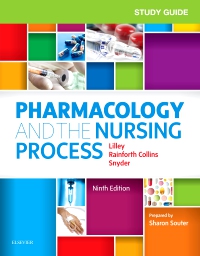
Study Guide for Pharmacology and the Nursing Process Elsevier eBook on VitalSource, 9th Edition
Elsevier eBook on VitalSource

Gift your students with the need-to-know pharmacology nursing skills to succeed on the NCLEX® and beyond with Study Guide for Pharmacology and the Nursing Process, 9th Edition! Designed to accompany Lilley’s Pharmacology and the Nursing Process, 9th Edition textbook, this workbook features worksheets for each chapter that include NCLEX-RN® Examination-style review questions, critical thinking and application questions, case studies, and other educationally sound learning activities.
Newer Edition Available
Study Guide for Pharmacology and the Nursing Process Elsevier eBook on VitalSource
-
- NEW! Updated content is completely current and ensures that the Study Guide content is consistent with the Lilley textbook.
- NEW! Expanded NCLEX focus includes one to two additional NCLEX Examination-style questions for each chapter, including additional alternate item format types.
- Chapter-by-chapter worksheets are divided into 3 main sections: Chapter Review and NCLEX Examination Preparation, Critical Thinking and Application, and Case Study.
- Chapter review and NCLEX® Examination preparation included in each chapter worksheet contains a number of application-based NCLEX practice questions, including at least one alternate-item question per chapter.
- Focus on prioritization features at least one prioritization exercise in which the student must evaluate a clinical scenario and answer the question: "What is the nurse’s best action?"
- Overview of dosage calculations section contains explanations of key drug calculations, concepts, sample drug labels, practice problems, and a practice quiz.
- Learning strategies expands upon the unique, cartoon-illustrated study strategies included in the Lilley text.
- Answers for all exercises are provided at the back of the book to facility self-study.
-
- NEW! Updated content is completely current and ensures that the Study Guide content is consistent with the Lilley textbook.
- NEW! Expanded NCLEX® focus includes one to two additional NCLEX Examination-style questions for each chapter, including additional alternate item format types.
-
PART 1: PHARMACOLOGY BASICS
1. The Nursing Process and Drug Therapy
2. Pharmacologic Principles
3. Lifespan Considerations
4. Cultural, Legal, and Ethical Considerations
5. Medication Errors: Preventing and Responding
6. Patient Education and Drug Therapy
7. Over-the-Counter Drugs and Herbal and Dietary Supplements
8. Gene Therapy and Pharmacogenomics
9. Photo Atlas of Drug AdministrationPART 2: DRUGS AFFECTING THE CENTRAL NERVOUS SYSTEM
10. Analgesic Drugs
11. General and Local Anesthetics
12. Central Nervous System Depressants and Muscle Relaxants
13. Central Nervous System Stimulants and Related Drugs
14. Antiepileptic Drugs
15. Antiparkinson Drugs
16. Psychotherapeutic Drugs
17. Substance Use DisorderPART 3: DRUGS AFFECTING THE AUTONOMIC NERVOUS SYSTEM
18. Adrenergic Drugs
19. Adrenergic-Blocking Drugs
20. Cholinergic Drugs
21. Cholinergic-Blocking DrugsPART 4: DRUGS AFFECTING THE CARDIOVASCULAR AND RENAL SYSTEMS
22. Antihypertensive Drugs
23. Antianginal Drugs
24. Heart Failure Drugs
25. Antidysrhythmic Drugs
26. Coagulation Modifier Drugs
27. Antilipemic Drugs
28. Diuretic Drugs
29. Fluids and ElectrolytesPART 5: DRUGS AFFECTING THE ENDOCRINE AND REPRODUCTIVE SYSTEMS
30. Pituitary Drugs
31. Thyroid and Antithyroid Drugs
32. Antidiabetic Drugs
33. Adrenal Drugs
34. Women’s Health Drugs
35. Men’s Health DrugsPART 6: DRUGS AFFECTING THE RESPIRATORY SYSTEM
36. Antihistamines, Decongestants, Antitussives, and Expectorants
37. Respiratory DrugsPART 7: ANTIINFECTIVE AND ANTIINFLAMMATORY DRUGS
38. Antibiotics Part 1
39. Antibiotics Part 2
40. Antiviral Drugs
41. Antitubercular Drugs
42. Antifungal Drugs
43. Antimalarial, Antiprotozoal, and Anthelmintic Drugs
44. Antiinflammatory and Antigout DrugsPART 8: CHEMOTHERAPEUTIC DRUGS AND BIOLOGIC AND IMMUNE MODIFIERS
45. Antineoplastic Drugs Part 1: Cancer Overview and Cell Cycle–Specific Drugs
46. Antineoplastic Drugs Part 2: Cell Cycle–Nonspecific Drugs and Miscellaneous Drugs
47. Biologic Response–Modifying and Antirheumatic Drugs
48. Immunosuppressant Drugs
49. Immunizing DrugsPART 9: DRUGS AFFECTING THE GASTROINTESTINAL SYSTEM AND NUTRITION
50. Acid-Controlling Drugs
51. Bowel Disorder Drugs
52. Antiemetic and Antinausea Drugs
53. Vitamins and Minerals
54. Anemia Drugs
55. Nutritional SupplementsPART 10: DERMATOLOGIC, OPHTHALMIC, AND OTIC DRUGS
56. Dermatologic Drugs
57. Ophthalmic Drugs
58. Otic DrugsAnswer Key



 as described in our
as described in our 